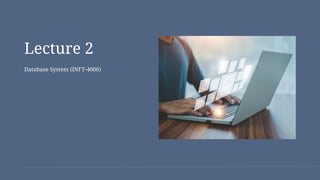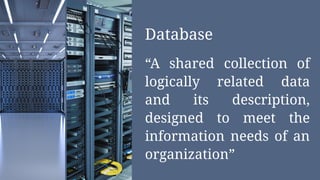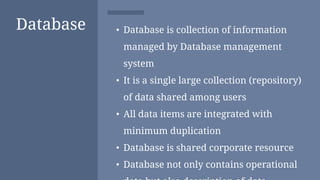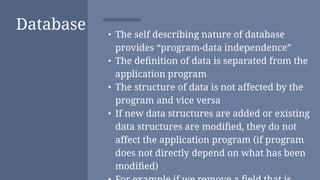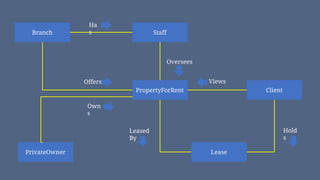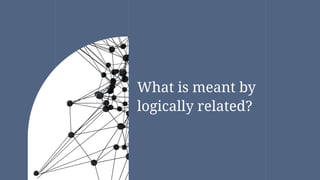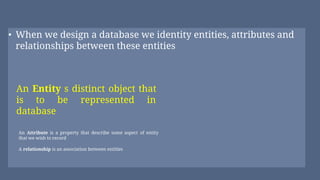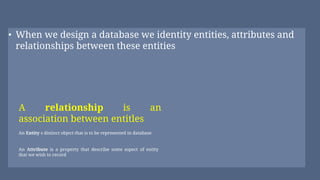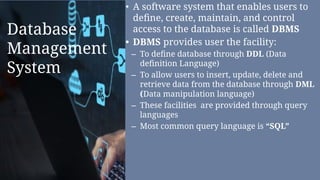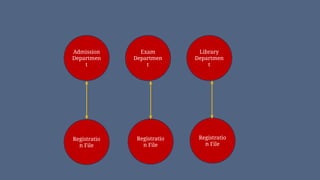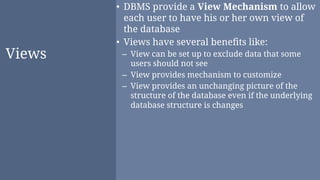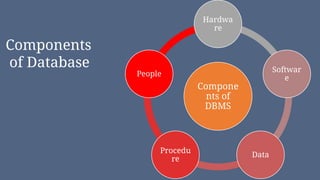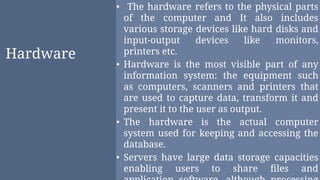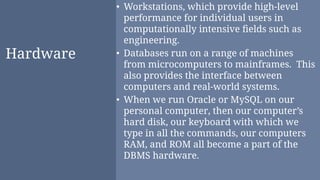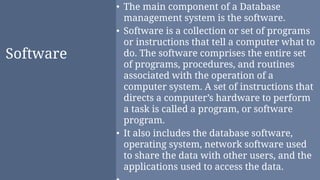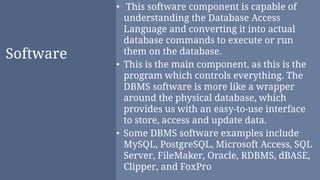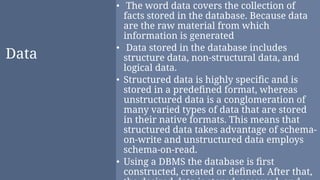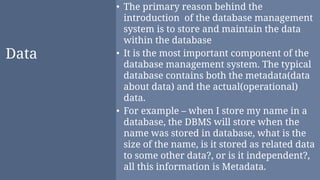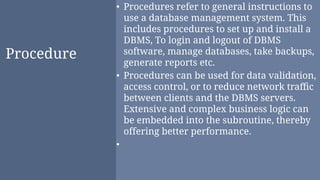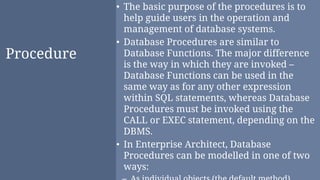Lect_2_dbms_its_rnvironment_and_components
- 1. Lecture 2 Database System (INFT-4006)
- 2. Database ŌĆ£A shared collection of logically related data and its description, designed to meet the information needs of an organizationŌĆØ
- 3. Database ŌĆó Database is collection of information managed by Database management system ŌĆó It is a single large collection (repository) of data shared among users ŌĆó All data items are integrated with minimum duplication ŌĆó Database is shared corporate resource ŌĆó Database not only contains operational
- 4. Database ŌĆó The self describing nature of database provides ŌĆ£program-data independenceŌĆØ ŌĆó The de’¼ünition of data is separated from the application program ŌĆó The structure of data is not affected by the program and vice versa ŌĆó If new data structures are added or existing data structures are modi’¼üed, they do not affect the application program (if program does not directly depend on what has been modi’¼üed)
- 6. What is meant by logically related?
- 7. ŌĆó When we design a database we identity entities, attributes and relationships between these entities An Attribute is a property that describe some aspect of entity that we wish to record A relationship is an association between entitles An Entity s distinct object that is to be represented in database
- 8. ŌĆó When we design a database we identity entities, attributes and relationships between these entities An Attribute is a property that describe some aspect of entity that we wish to record A relationship is an association between entitles An Entity s distinct object that is to be represented in database
- 9. ŌĆó When we design a database we identity entities, attributes and relationships between these entities An Attribute is a property that describe some aspect of entity that we wish to record A relationship is an association between entitles An Entity s distinct object that is to be represented in database
- 10. Database Management System ŌĆó A software system that enables users to de’¼üne, create, maintain, and control access to the database is called DBMS ŌĆó DBMS provides user the facility: ŌĆō To de’¼üne database through DDL (Data de’¼ünition Language) ŌĆō To allow users to insert, update, delete and retrieve data from the database through DML (Data manipulation language) ŌĆō These facilities are provided through query languages ŌĆō Most common query language is ŌĆ£SQLŌĆØ
- 11. (Database) Application Programs ŌĆó A computer program that interacts with the database by issuing an appropriate request to DBMS is call Application Program ŌĆó Users interact with database through Application program ŌĆó Application programs are written in high level programming languages or higher level programming languages (fourth generation languages e.g. SQL)
- 13. Data Entry and Reports Data Entry and Reports DBMS Registration Database Exa m Fe e Fee application program Exam application program
- 14. Views ŌĆó DBMS provide a View Mechanism to allow each user to have his or her own view of the database ŌĆó Views have several bene’¼üts like: ŌĆō View can be set up to exclude data that some users should not see ŌĆō View provides mechanism to customize ŌĆō View provides an unchanging picture of the structure of the database even if the underlying database structure is changes
- 16. Hardware ŌĆó The hardware refers to the physical parts of the computer and It also includes various storage devices like hard disks and input-output devices like monitors, printers etc. ŌĆó Hardware is the most visible part of any information system: the equipment such as computers, scanners and printers that are used to capture data, transform it and present it to the user as output. ŌĆó The hardware is the actual computer system used for keeping and accessing the database. ŌĆó Servers have large data storage capacities enabling users to share ’¼üles and
- 17. Hardware ŌĆó Workstations, which provide high-level performance for individual users in computationally intensive ’¼üelds such as engineering. ŌĆó Databases run on a range of machines from microcomputers to mainframes. This also provides the interface between computers and real-world systems. ŌĆó When we run Oracle or MySQL on our personal computer, then our computerŌĆÖs hard disk, our keyboard with which we type in all the commands, our computers RAM, and ROM all become a part of the DBMS hardware.
- 18. Software ŌĆó The main component of a Database management system is the software. ŌĆó Software is a collection or set of programs or instructions that tell a computer what to do. The software comprises the entire set of programs, procedures, and routines associated with the operation of a computer system. A set of instructions that directs a computerŌĆÖs hardware to perform a task is called a program, or software program. ŌĆó It also includes the database software, operating system, network software used to share the data with other users, and the applications used to access the data.
- 19. Software ŌĆó This software component is capable of understanding the Database Access Language and converting it into actual database commands to execute or run them on the database. ŌĆó This is the main component, as this is the program which controls everything. The DBMS software is more like a wrapper around the physical database, which provides us with an easy-to-use interface to store, access and update data. ŌĆó Some DBMS software examples include MySQL, PostgreSQL, Microsoft Access, SQL Server, FileMaker, Oracle, RDBMS, dBASE, Clipper, and FoxPro
- 20. Data ŌĆó The word data covers the collection of facts stored in the database. Because data are the raw material from which information is generated ŌĆó Data stored in the database includes structure data, non-structural data, and logical data. ŌĆó Structured data is highly speci’¼üc and is stored in a prede’¼üned format, whereas unstructured data is a conglomeration of many varied types of data that are stored in their native formats. This means that structured data takes advantage of schema- on-write and unstructured data employs schema-on-read. ŌĆó Using a DBMS the database is ’¼ürst constructed, created or de’¼üned. After that,
- 21. Data ŌĆó The primary reason behind the introduction of the database management system is to store and maintain the data within the database ŌĆó It is the most important component of the database management system. The typical database contains both the metadata(data about data) and the actual(operational) data. ŌĆó For example ŌĆō when I store my name in a database, the DBMS will store when the name was stored in database, what is the size of the name, is it stored as related data to some other data?, or is it independent?, all this information is Metadata.
- 22. Procedure ŌĆó Procedures refer to general instructions to use a database management system. This includes procedures to set up and install a DBMS, To login and logout of DBMS software, manage databases, take backups, generate reports etc. ŌĆó Procedures can be used for data validation, access control, or to reduce network tra’¼āc between clients and the DBMS servers. Extensive and complex business logic can be embedded into the subroutine, thereby offering better performance. ŌĆó
- 23. Procedure ŌĆó The basic purpose of the procedures is to help guide users in the operation and management of database systems. ŌĆó Database Procedures are similar to Database Functions. The major difference is the way in which they are invoked ŌĆō Database Functions can be used in the same way as for any other expression within SQL statements, whereas Database Procedures must be invoked using the CALL or EXEC statement, depending on the DBMS. ŌĆó In Enterprise Architect, Database Procedures can be modelled in one of two ways:
- 24. People ŌĆó People perform different roles in database environment ŌĆō Data Administrator ŌĆō Database Administrator ŌĆō Database Designer ŌĆō Application Developer ŌĆō End Users
- 25. Any Question?
